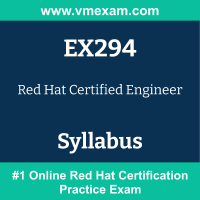 The Red Hat EX294 exam preparation guide is designed to provide candidates with necessary information about the RHCE exam. It includes exam summary, sample questions, practice test, objectives and ways to interpret the exam objectives to enable candidates to assess the types of questions-answers that may be asked during the Red Hat Certified Engineer (RHCE) exam.
The Red Hat EX294 exam preparation guide is designed to provide candidates with necessary information about the RHCE exam. It includes exam summary, sample questions, practice test, objectives and ways to interpret the exam objectives to enable candidates to assess the types of questions-answers that may be asked during the Red Hat Certified Engineer (RHCE) exam.
It is recommended for all the candidates to refer the EX294 objectives and sample questions provided in this preparation guide. The Red Hat RHCE certification is mainly targeted to the candidates who want to build their career in Linux Administrator domain and demonstrate their expertise. We suggest you to use practice exam listed in this cert guide to get used to with exam environment and identify the knowledge areas where you need more work prior to taking the actual Red Hat Certified Engineer exam.
Red Hat EX294 Exam Summary:
| Exam Name | Red Hat Certified Engineer (RHCE) |
| Exam Code | EX294 |
| Exam Price | $400 USD |
| Duration | 240 minutes |
| Number of Questions | 20 |
| Passing Score | 210 / 300 |
| Schedule Exam | PEARSON VUE |
| Sample Questions | Red Hat EX294 Sample Questions |
| Recommended Practice | Red Hat Certified Engineer (RHCE) Practice Test |
Red Hat RHCE Syllabus:
| Section | Objectives |
|---|---|
| Be able to perform all tasks expected of a Red Hat Certified System Administrator |
- Understand and use essential tools - Operate running systems - Configure local storage - Create and configure file systems - Deploy, configure, and maintain systems - Manage users and groups - Manage security |
| Understand core components of Ansible |
- Inventories - Modules - Variables - Facts - Loops - Conditional tasks - Plays - Handling task failure - Playbooks - Configuration files - Roles - Use provided documentation to look up specific information about Ansible modules and commands |
| Use roles and Ansible Content Collections |
- Create and work with roles - Install roles and use them in playbooks - Install Content Collections and use them in playbooks - Obtain a set of related roles, supplementary modules, and other content from content collections, and use them in a playbook. |
| Install and configure an Ansible control node |
- Install required packages - Create a static host inventory file - Create a configuration file - Create and use static inventories to define groups of hosts |
| Configure Ansible managed nodes |
- Create and distribute SSH keys to managed nodes - Configure privilege escalation on managed nodes - Deploy files to managed nodes - Be able to analyze simple shell scripts and convert them to playbooks |
| Run playbooks with Automation content navigator |
- Know how to run playbooks with Automation content navigator - Use Automation content navigator to find new modules in available Ansible Content Collections and use them - Use Automation content navigator to create inventories and configure the Ansible environment |
| Create Ansible plays and playbooks |
- Know how to work with commonly used Ansible modules - Use variables to retrieve the results of running a command - Use conditionals to control play execution - Configure error handling - Create playbooks to configure systems to a specified state |
| Automate standard RHCSA tasks using Ansible modules that work with: |
- Software packages and repositories - Services - Firewall rules - File systems - Storage devices - File content - Archiving - Task scheduling - Security - Users and groups |
| Manage content |
- Create and use templates to create customized configuration files - Use Ansible Vault in playbooks to protect sensitive data |
